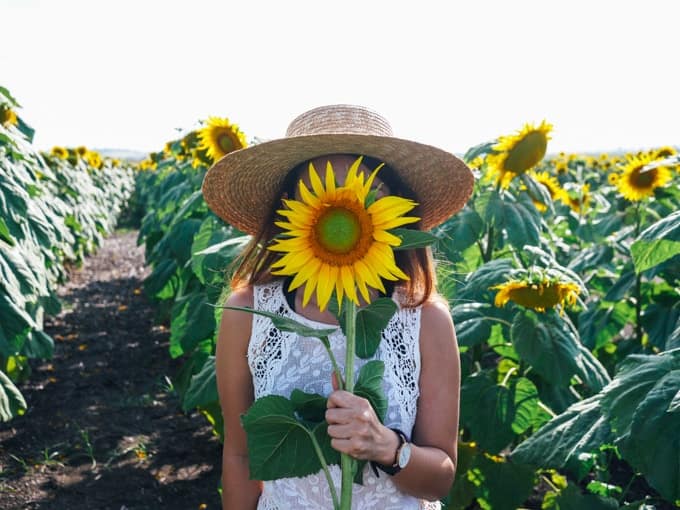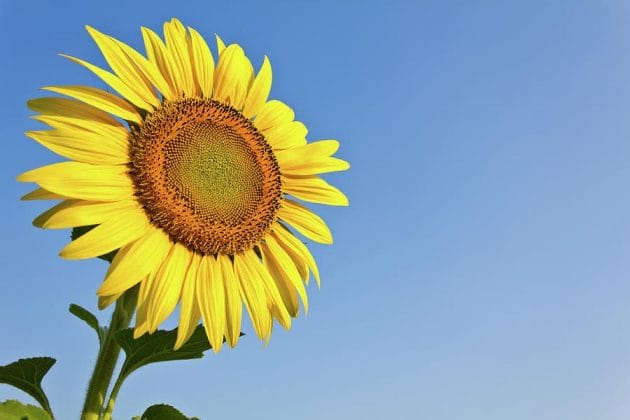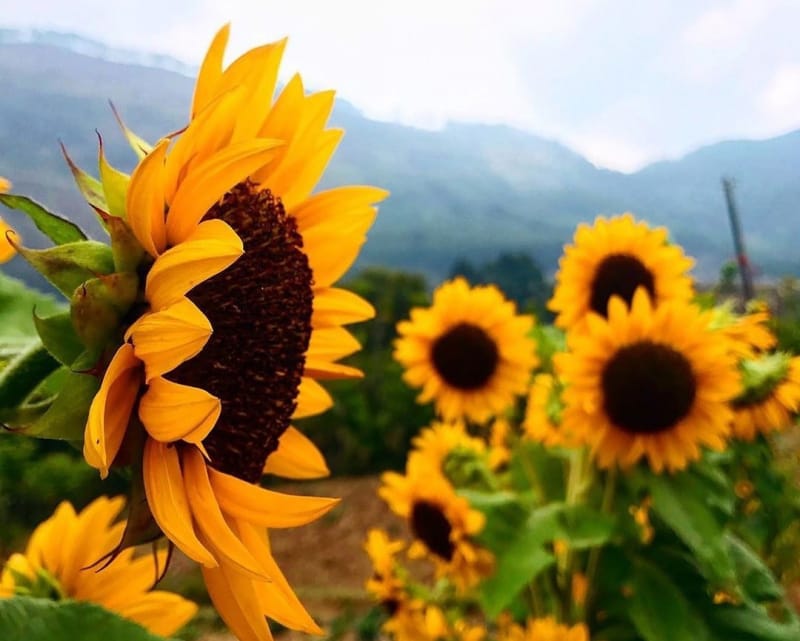What is a Sunflower?
The sunflower is a flower that is predominantly yellow with a hint of red. Its large head spans 19 – 27cm and is surrounded by numerous petals with a dark center. This flower is native to multiple countries, and its meaning varies across cultures. In neighboring China, the sunflower symbolizes longevity, while in Europe, it represents steadfastness and a forward-looking perspective.
Sunflower Characteristics
Stem: Sunflowers are herbaceous and annual plants with straight and sturdy stems covered in fine hair. They typically grow to a height of 1-3.5 meters.
Leaves: Sunflower leaves are large, pointed at the tip, and heart-shaped at the base. The leaf stalks are long, and both sides of the leaves are covered in fine white hair.
Flowers: Sunflowers have large flower heads with a diameter of 7-20cm. The flowers bloom widely, with evenly arranged, bright yellow petals.
Seeds: Sunflowers take around 3-5 months to bloom fully. After the petals wither, the seeds become visible. Sunflowers are propagated by seeds, and the offspring inherit the same characteristics as the parent plant.
Always Facing the Sun
Perhaps the most well-known characteristic of sunflowers is their tendency to face the sun. In the morning, when the sun rises, sunflowers face east. In the afternoon, as the sun moves towards the west, the flowers turn accordingly to face the sunlight. The origin of the flower’s name is derived from this very trait.
Sunflowers always seek out the sunlight
The Fastest-Growing Flower
Sunflowers are known for their rapid growth, earning the title of “queen” in this aspect. Sunflower plants can reach heights of 2.4 to 3 meters in just six months from planting. This remarkable growth rate has led to the flower’s association with success and upward mobility.
Sunflowers are the fastest-growing flowers
Sunflower Seeds Form a Natural Spiral Pattern
If you look closely at the center of a sunflower, you’ll notice that the seeds are arranged in a natural spiral pattern. Interestingly, the number of spirals always corresponds to a pair of consecutive Fibonacci numbers: 21 and 34; 34 and 55; 55 and 89; or 89 and 144.
The sunflower’s center forms a unique spiral pattern
Significance of Sunflowers
Sunflowers in Love and Life
Sunflowers are known for their affinity for sunlight, and this trait is reflected in their symbolic meaning. They represent faithfulness and the dedication to keep one’s mind focused on their loved one, no matter the distance. The name “sunflower” itself originates from this quality.

This flower serves as a fascinating metaphor for life and relationships.
Feng Shui Significance of Sunflowers
Sunflowers represent the daytime and are believed to bring warm and bright energy to any space. They symbolize happiness and good fortune and are often used to decorate spaces during grand openings, inaugurations, and festive occasions.

With their vibrant yellow color, sunflowers easily become the focal point of any space, making them a popular choice for special occasions.
Significance of Sunflowers on November 20th
Sunflowers represent faith, hope, and the aspiration to reach for the light. They are often given as gifts to teachers to express gratitude and respect for their role in guiding and shaping the minds of the younger generation.
In Chinese culture, sunflowers are associated with longevity. As these flowers bloom during the harsh summer and winter months, their resilience and strong life force make them a popular gift for older individuals.
Color Significance of Sunflowers
Sunflowers typically come in two colors: yellow and red. While yellow is the most commonly cultivated color, each color carries a unique meaning.
Red Sunflowers: Red sunflowers symbolize luck, vitality, optimism, and the spirit of perseverance.
Yellow Sunflowers: Yellow sunflowers, the most popular variety, represent prosperity, longevity, wealth, and happiness.

There are also white sunflowers, which symbolize purity and innocence, although they are less common.
Other Uses of Sunflowers
Economic Value: Sunflowers have high economic value, as various parts of the plant, including the stem, flowers, and seeds, are utilized. Growing sunflowers can provide a significant income for farmers.
Food and Nutrition: Sunflower seeds are commonly used in baking to enhance flavor and nutrition. The leaves and stems can also be used as animal feed.
Health Benefits: Sunflower seed oil is known for its nutritional benefits and is used to boost the immune system and treat various ailments.
Aesthetic Value: Sunflowers are aesthetically pleasing and are often planted to beautify landscapes, gardens, and public spaces. The practice of growing sunflowers was adopted from American countries, and it has gained popularity in Vietnam.
Sunflower Blooming Season
Sunflowers typically bloom during the fall and winter months, from July to December. To ensure a timely and vibrant bloom, it is recommended to plant the seeds 70-90 days in advance. Sunflowers are usually grown in large clusters, creating a stunning visual spectacle that attracts tourists and visitors.
Guide to Growing and Caring for Sunflowers
Choose Healthy Seeds: Select seeds that are free from pests and diseases, preferably sourced from a vigorous and healthy plant.
Planting Time: Sunflowers thrive in warm and sunny weather. They grow well in harsh climates and perform best when exposed to ample sunlight. The ideal planting time is from January to June.
Seed Germination: Before planting, soak the seeds in damp cloth for 5-10 days to increase the germination rate. Once the seeds have sprouted, they can be planted. Be careful not to let the sprouts grow too long before planting, as this can cause damage to the delicate roots.
Planting Process: Prepare furrows for planting, ensuring a distance of 30-90cm between each furrow, depending on the size of the plants. Maintain a distance of 15-20cm between each seed. This ensures optimal growth conditions.
Watering: Regular watering is essential, especially in hot and dry conditions. Water the plants thoroughly in the early morning, providing enough moisture to last throughout the day.
Staking: As the sunflowers grow taller, reaching a height of 30-50cm, it is crucial to provide support by staking the plants. This helps them grow straight and prevents them from toppling over.
Care and Maintenance: Regularly remove weeds and provide fertilizer at regular intervals to promote healthy growth. Use NPK 16-16-8 fertilizer every two weeks after the seedlings reach a height of 40-50cm. Once the plants start to flower, switch to NPK 16-8-16 fertilizer to increase potassium levels, promoting larger and more vibrant blooms.


































